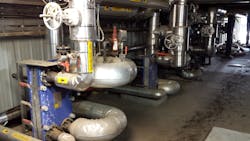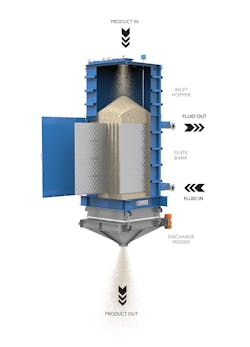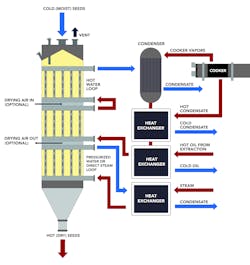Vertical plate heat exchangers and the greening of bulk solids processing
Bulk solid materials represent the building blocks of our everyday lives, from the sugar in our coffee and fertilizer on our lawns to the polymers that make up our water bottles and the metal powder in our electric vehicles’ battery cells. Whether the final product is a powder, granule, tablet, pellet or crystal, most bulk solids go through a variety of processes during manufacturing, which often includes some form of heating, cooling and/or drying. As these processes can be very energy intensive, manufacturers of products such as fertilizer, oilseeds, minerals and chemicals are increasingly looking to heat exchange technology to reduce costs and carbon footprint while still producing consistently high-quality products.
Fixed or moving bed heat exchangers (MBHEs) have operated in the heating, cooling and drying space for generations, often in the form of fluid beds and rotary drums. In these traditional technologies, the heat transfer media — or working fluid — is in direct contact with the bulk solid material.
However, many industries are now turning to MBHEs that use vertical plate technology to indirectly heat and cool material via conduction across the surface of vertical steel plates. This technology, which can also be used to dry solids, has shifted the framework of what is possible in both traditional and non-traditional bulk solids industries.
How vertical plate heat exchangers work
MBHEs that use vertical plate technology have a long lineage that traces back to plate heat exchangers (PHE), which are still commonplace in numerous process industries. While traditional PHEs are limited to components that allow heat transfer from one fluid (liquid or gas) to another fluid, MBHEs that use vertical plate technology allow the indirect heat transfer between solids and fluids.
In a MBHE, the material enters the unit and flows by gravity through banks of parallel vertical stainless-steel plates, while a heat transfer fluid passes through the plates to heat or cool the material by conduction. The fluid commonly flows through the plates in a countercurrent direction to the solids for enhanced thermal efficiency. A mass flow discharge feeder controls the rate of flow through the unit while providing uniform material drawdown. Gravity is the mechanism that slowly moves the material through the heat exchanger.
Complex thermal modeling calculations using proprietary material property data are key to the effectiveness of MBHE technology and guarantees precise discharge temperature control. This ensures optimal product temperature to storage and transport, which is key in many industries such as fertilizer and sugar.
Managing energy consumption
Using indirect heat exchange through plate-based technology offers numerous benefits for bulk solids processors, and many of these benefits are becoming more pronounced as improved sustainability and a reduced carbon footprint become important business priorities in industries around the world.
For one, the energy required to operate a MBHE with vertical plate technology is significantly less than traditional technology. Water, which is often the primary heat transfer fluid used in these units, is a more effective heat transfer medium than air and has many practical benefits such as ease of energy recovery, lack of baghouse or cyclone requirements and a high degree of control and accuracy where required. Particularly where a combination of heating fluid and drying air can be used instead of just drying air, waste energy and particulate emissions can be reduced while improving flexibility to supplement with green energy sources or recovered waste heat.
For a fluid system, the associated water pump, bucket elevator and purge air system also have low horsepower requirements. And plate-based technology does not typically require the use of significant air-handling equipment.
By comparison, fluid beds, for example, rely on heating ambient air, with large fans blowing that air through the material bed. The air then needs to be cleaned before being discharged to the environment. This process requires at least two powerful large-horsepower fans: a forced draft fan to supply air to the unit, and an induced draft fan following, for example, a scrubber.
As a result of its high thermal efficiency and minimal energy requirements, MBHE technology can save up to 4 or 5 kWh/tonne of material compared to a fluid bed system. This is based on typical operational power requirements of 1,040 kW for a fluid bed cooler for a 3,600 tonne-per-day urea plant on the U.S. Gulf Coast (based on mean monthly day and night ambient conditions). That compares with an equivalent 85 kW requirement for a MBHE using vertical plate technology.
How does this translate into savings for operators? In the fertilizer industry, for example, industry estimates peg power consumption of up to 1.7 MW for cooling 100 tonnes per hour of product using either fluid beds or rotary coolers. This can be translated to annual electrical energy costs of approximately $744,000 US.
Vertical plate technology can reduce power consumption to just 170 kW for the same fertilizer capacity, resulting in energy savings of more than $600,000 US per year.
Minimizing carbon footprint
Vertical plate technology also offers the benefit of producing significantly lower emissions than direct-contact alternatives.
Because MBHEs rely on fluids such as water rather than air as the heat transfer medium, they minimize emissions, dust and odors. Notably, the low flow velocity (typically less than 0.3 m/min) and gentle handling of the material prevents excessive segregation as well as particle degradation in friable materials such as fertilizers, which also reduces dust.
Direct-contact heat exchange requires air to be forced through the material to create an agitated or fluidized bed. This can cause particle attrition, leading to increased fugitive dust and emissions. Without adequate control and cleaning systems, fugitive dust can significantly impact the operations and the environment around a processing plant. And emissions must be cleaned and scrubbed before being discharged into the atmosphere to meet ever-tightening pollution controls. This leads to higher energy costs to operate the expanded air-handling and wet-scrubbing systems these technologies require. Also, regulatory permits for discharge stacks are becoming increasingly difficult to acquire.
Vertical plate technology has been proven to offer a significantly lower overall carbon footprint than direct-contact alternatives. Research by Solex Thermal Science shows that the indirect method of cooling fertilizer creates just 0.42 kg of CO2 emissions per 1 kWh, which is an estimated eight times less than comparable heat exchange technologies.
Recovering waste heat
As manufacturers leave no stone unturned when looking to reduce their carbon footprint, they are also looking at MBHEs as a way to reuse otherwise wasted heat. Waste heat can originate from many different places in a processing plant. For example, it could be heat recovered from the hot material or airstream at the discharge from a thermal processing step, such as a calciner. In this case, that heat can be looped back to preheat the feed material going to the thermal processor.
Energy recovery from a variety of process steps is common in the oilseed industry. The cold seeds are heated up with waste heat coming from vapors generated during the cooking process, steam condensate and/or flash steam coming from other processes. Capturing and reusing this heat energy greatly improves the thermal efficiency of the process.
Because most of this waste energy is low-grade process heat that is usually discharged to the environment, its temperature is typically too low to make recovery and use viable with traditional direct-contact heat exchange technologies. For example, condensate is typically around 90°C, hot oil is in the 80-95°C range and vapors are around 80°C.
Plate technology, however, offers significantly more heat transfer area than the tube technology that has been commonly used within the same space, making the recovery of low-grade waste heat viable. A standard plate-style unit measuring 3.3 m by 3.3 m by 1 m can offer about 420 square meters of heat transfer area, about twice that of tubes.
Improving water management
Manufacturers are always looking to better manage their fresh water supplies and many currently face water scarcity or quality issues. While water plays a vital role in the operation of vertical plate technology, the system operates on a secondary self-contained water circuit with a plate exchanger isolating the unit from the primary plant cooling water supply.
The cooling water’s temperature is controlled by a module before it is circulated through the plates. This ensures a consistent water temperature regardless of varying operating conditions.
An added benefit to a self-contained water circuit is that the water does not contain organics or dissolved solids from entering the water stream. Because the water circulates within a closed loop, it enters the plates clean each time. This eliminates corrosion concerns and ensures effective heat transfer over the life of the heat exchanger by preventing scaling and fouling.
Greening bulk solids processing
Wasted energy, excessive greenhouse gas emissions and unregulated use of dwindling fresh water supplies are no longer acceptable. As a result, both stakeholders and customers are holding industries globally to incredibly high environmental, social and corporate governance (ESG) standards. This is driving the adoption of technologies that help manufacturers align with their energy and environmental goals.
The heating, cooling and drying stages of bulk solids processing not only represent vital steps in producing a quality finished product, but also now fill critical roles in meeting manufacturers’ broader sustainable initiatives. MBHEs that use vertical plate technology to indirectly heat, cool or dry bulk solids provide a much-needed solution that supports the push toward a greener future.
Devon Robinson is an applications engineer at Solex Thermal Science, a Canadian company that specializes in thermal and bulk materials engineering.
Solex Thermal Science
About the Author
Devon Robinson
Applications engineer at Solex Thermal Science
Devon Robinson is an applications engineer at Solex Thermal Science, a Canadian-headquartered company that specializes in thermal and bulk materials engineering. For more information, visit solexthermal.com.


